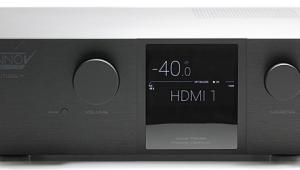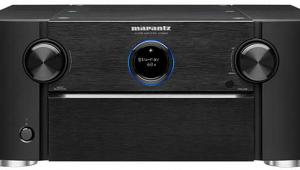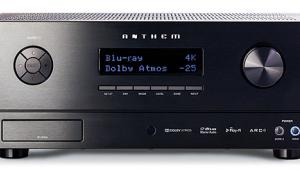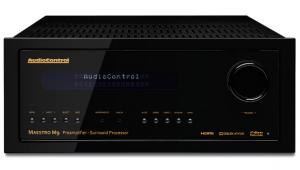They can be manually adjusted or imported through numerous ARC runs before being linked to inputs. | car accidents on private property
Anthem AVM 60 A/V Processor Review Page 2
The Sound
Judged with ARC off, the AVM 60 sounded...well, it just didn’t. It was effectively invisible. Whether I auditioned two-channel or multi-channel recordings of music or movies in standard-def or hi-res, the Anthem doled out my chosen source materials as close to precisely as I knew them to be. In other words, it was close enough to perfectly transparent to impose no discrete sound of its own. Does this make the AVM 60 a unique performer? I don’t think so; any competently designed line-level component of substantial cost should be exactly so, and the Anthem, to my ears, certainly was. This meant that even the most demanding of my hi-res files retained all their expected virtues. For one example, a 96/24 of Schumann’s Humoreske (Richard Goode; Nonesuch) sparkled with the tone colors and dynamic shadings of the incomparable pianist, and with a finely drawn rendition of hall sound. Most important, the Anthem raised no impediment to listening fully “into” the recording’s resonant, richly textured piano sound.
 Anthem’s palette of surround modes for the AVM 60 is rigorously constrained. Besides the full complement of Dolby and DTS decoders, delivering everything up to Atmos and (eventually) DTS:X, you get Dolby Surround (the “PLII” moniker has been dropped, post-Atmos) and DTS Neo:6 as options for upscaling of stereo-to-multichannel. On a DTS:X disc like Whiskey Tango Foxtrot, the AVM 60’s display read only “DTS-HD Master,” and no height-channel sound was output. But an Atmos production like Terminator: Genisys wowed via my 5.1.4 setup. In the climactic T-on-geriatric-T fight scene of chapter 16, the verticality of the catwalk setting was dramatically evident, while the sharply etched mechanical slams of the music score delivered their metallic hammer-blows with impressive clarity. Genisys the film may not rank with the earlier Terminator-series classics (understatement of the month), but its soundtrack can stand with the predecessors.
Anthem’s palette of surround modes for the AVM 60 is rigorously constrained. Besides the full complement of Dolby and DTS decoders, delivering everything up to Atmos and (eventually) DTS:X, you get Dolby Surround (the “PLII” moniker has been dropped, post-Atmos) and DTS Neo:6 as options for upscaling of stereo-to-multichannel. On a DTS:X disc like Whiskey Tango Foxtrot, the AVM 60’s display read only “DTS-HD Master,” and no height-channel sound was output. But an Atmos production like Terminator: Genisys wowed via my 5.1.4 setup. In the climactic T-on-geriatric-T fight scene of chapter 16, the verticality of the catwalk setting was dramatically evident, while the sharply etched mechanical slams of the music score delivered their metallic hammer-blows with impressive clarity. Genisys the film may not rank with the earlier Terminator-series classics (understatement of the month), but its soundtrack can stand with the predecessors.
Otherwise, there’s just a single “extra” surround mode, AnthemLogic, with Music and Cinema options. These “minimalist” processes exploit no reverberation or other DSP sweetening, deploying only channel-separating and -steering algorithms to derive subtle but useful surround from two-channel or encoded sources. I liked them both a good deal. AnthemLogic Music sounded very slightly deeper but still well anchored and ultra-clean on exposed material like voice and piano (Elgar songs, from a Channel Classics download). With the height channels engaged, AnthemLogic used them, fairly subtly, to add a nice arching proscenium to the soundstage, which worked excellently for concert music.
A full rotation of Dolby Atmos and DTS-HD Master Audio movie scenes exposed no weaknesses. The AVM 60 presented each with full dynamic impact and full spatial breadth, depth, and height (in the Atmos cases). Until Anthem makes their DTS:X software available, having multiple setup Profiles eases the complexity of switching between Atmos and height-less DTS presentations.
After downloading the iOS version of DTS’s Play-Fi app, I had no difficulty streaming free internet radio or demos of the app’s pay services, which include Pandora, Spotify, Tidal, and many others. It also streamed my iMac-based DLNA music server (TwonkyMedia), including hi-res FLAC and WAV files (plus AAC, ALAC, and MP3) via Play-Fi’s Hi-Res Audio mode, which dedicates full wireless bandwidth to a single destination “speaker”—in this case, the AVM 60. PlayFi lets you assemble multiroom wireless systems with multiple compatible wireless speakers or amps/preamps/receivers, making stereo groupings and multiple-room playback fairly flexible. However, while it is hi-res capable, it does not handle DSD. In all cases, playback sounded pristine and glitch-free. I rated Play-Fi’s ergonomics as middling: The app delivers volume control but nothing else, which means you have to juggle the phone or tablet and the pre/pro’s own remote for any further functions.
The Stuff
It’s clear that Anthem went to some effort to make the AVM 60 (and its sibling receivers) as simple as human ingenuity could achieve. Witness the long list of left-off features, or the paucity of unlikely-to-be-needed inputs and outputs such as S- or component-video.
But perhaps the best proof is the excellent owner’s manual: a real, printed hard copy, provided in the box. This numbers just 46 uncrowded pages—and of these, a dozen are setup diagrams, and seven are ARC directives. The entire “Operations” section is just five pages— terse, but I sensed no important omissions. The manual is a model of clarity and concision.

Anthem’s remote is similar: clear, generously laid out, and eminently usable, in large part because it omits any direct-access input keys. Instead, there’s an Input button that calls up a menu of your active choices, selected via up/down/enter. This is an intelligent compromise, and it leaves room for a welcome, discrete eight-key grouping of dedicated Zone 2 controls. The menus themselves are simple, fast to respond, logically organized, and (for the most part) brief.
Nonetheless, Anthem does include several remote-key conveniences that I, too, would check off if I were designing my own custom pre/pro. Dolby Volume/dynamic-range control is on board, and it’s accessible via a dedicated “Dyn” remote key. Even better, a Level key steps through each channel/pair for temporary trims, one of my mustest must-haves. There’s even a direct Lip Sync button for on-the-fly adjustments, a real convenience for those like myself who are driven nuts by out-of-kilter cable or internet programming.
The Sum-Up
At the end of the day, I found Anthem’s AVM 60 a pleasure to use. Its sonics were without blemish, and its interface was clean, clear, and quick. Price to one side, I would be perfectly happy having the Canadian design as my system’s long-term front end, and I’ve no higher praise. Of course, price is never entirely irrelevant. While $3,000 may be only lower-middling among all available preamp/processors, Anthem’s MRX 720 receiver provides almost all of the same preamp functionality, with seven channels of onboard power, for $500 less. Alas, that receiver’s five main channels can’t be reassigned, so unless you choose to “waste” them by leaving some or all unused, onboard power can only serve the “extra” channels: Height 1 & 2 and Zone 2. And yes, there are some big-brand 11.2-channel pre/pro options that come in at or below the AVM 60’s tariff, all more heavily feature-endowed—a plus or a minus, depending on your outlook. This leaves the intangibles of physical and sonic quality as the remaining weights on the scales—which, in the end, I can only leave up to each individual ’phile to balance. But to those to whom $2,999 seems reasonable, I can recommend the AVM 60 without hesitation.
- Log in or register to post comments


I recently purchased the Anthem AVM 60 A/V Processor, Thanks to Marietta Drywall Contractors recommendation. I am really enjoying it. It has a clean and simple design that makes it easy to use. The sound quality is pristine, and it has all the features I need.

Amazing! Glad to check this informative content on this site. crossfit gym

This is great! I like the design, it looks so handy. Zion Roof Pros Germantown

This content is exactly what I needed to see today—thank you for sharing it. https://www.thecommonspharmacy.com/health-services

It's worth it! The quality of this TV is exceptional. Cheers from our curb repair company!





























































